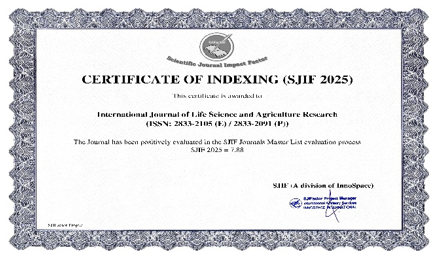A Survey on the Diversity of Field Insect Pests of Okro (Abelmoschus Esculentus) within the Six ADP Zones in Akwaibom State
DOI:
https://doi.org/10.55677/ijlsar/V03I6Y2024-05Keywords:
.Abstract
A survey was conducted to determine the diversity and abundance of insect pests associated with okra (Abelmoschus esculentus) across the six Agricultural Development Programme (ADP) zones in Akwa Ibom state namely; Uyo, Abak, Eket, Ikot ekpene, Etinan and Oron using multi – stage random sampling technique, swoop nets for flying insects, aspirators for collecting tiny insects, pair of forceps and hand picking for larvae and slow moving insects. A total of 634 insects were collected across the six zones and identified into 4 orders, 13 families and 15 species. The dominant order by specie was Hemiptera having (6/40%) followed by Lepidoptera (4/26.67%), Coleoptera (3/20%) and the least was Orthoptera having (2/13.33%) while dominant order by individuals was Coleoptera having 279/44.01%), followed by Hemiptera (244 /38.49%), Lepidoptera (68/10.73%) and the least was Orthoptera (43/6.78%). Dominant insect specie across the six zones was Flea beetle (Podagrica sp.) with total population of 185 followed by Aphids (Aphis gossypii - 98) and the least was Cabbage looper (Trichoplusia ni – 7). Diversity index result showed that Eket zone had the highest no. of individuals (122) with the least no. of species (12) and least Shannon index value (H_ 2.11) followed by Oron zone with 112 individuals, no. species (13) and shannon index ( H_2.31). Uyo zone had the least no. of individuals (93), no. species (13) and Shannon index (H_2.21) while Ikot ekpene zone had the highest Shannon index value (H_2.34) and highest no. of species (14) with no. of individual (101). This study reveals that there is high diversity and abundance of insect species attacking okra in Akwa Ibom State hence drastic control measures is imperative for successful and profitable production of Okra.
References
Abidi, A., Singh, P., Chauhan, V., Tiwari, B., Chauhan, S., Simon, S., Ahmad, S., (2018). An Overview on Okra (Abelmoschus Esculentus) and its Importance as a nutritive vegetable in the world. International Journal of Pharmacy and Biological Science (IJBS) Vol. 4, Iss. 2, Pp.227-233
Adamu RA, Dike MC, Akpa AD. 2000. Preliminary studies on insect pests of green gran (Vigna radiate L Wilezek) in Northern Guinea Savanna of Nigeria. In Entomology in Nation Building: The Nigerian Experience, Dike MC, Okunade SO, Okonkwo NO, Abba AA (eds). ESN Occational Pub., 32; 135-147.
Adebola, O. and GANA, J. (2016). Insect pest control and productivity of okro (Abelmoschus esculentus) trapped in between cowpea (Vigna unguiculata) and Roselle (Hibiscus sabdariffa) plants. Journal of Basic and Applied Sciences 2(1): 24 – 33.
Alegbejo M. (2004). Okra Cultivars with Moderate Resistance to Okra Mosiac virus genus Tymovirus. Nigerian Journal of Horticultural science. 8 (1).
Asawalam, E. F. and Chukwu, E. U.(2012). The effect of intercropping okra with ginger on the population of flea beetle (podagrica sjostedti jacoby coleoptera: chrysomelidae) and whitefly (bemisia tabaci genn homoptera: aleyrodidae) and the yield of okra in Umudike, Abia State, Nigeria. Journal of Agriculture and Biological Sciences. Vol.3(3) pp.300 –304
Ezcurra, E., Rapoport, E. H., and Marino, C. R. (1978). The Geographical Distribution of Insect Pests. Journal of Biogeography, 5(2), 149-157.
Fasunwon, B. T. and Banjo A. D. (2010). Seasonal Population Fluctuations of Podagrica sp. on Okra Plant (Abelmoschus esculentus). Research Journal of Agriculture and Biological Sciences, 6(3): 283-288, 20
FAO. (2020). Crop production manual. A guide to fruit and vegetable production in the Federated States of Micronesia doi: 10.4060/ca7556en.
Hussain, M., Tariq M., and Muhammad Z. (2011). Assessment of the damage caused by Meloidogyne incognita on okra (Abelmoschus esculentus). Journal of Animal & Plant Sciences, 21(4): Pp: 857-861.
Idowu, G. A., Oyewale, R. O., Bolajoko, M. H., Ibrahim, R. O., Isah, C. (2022). Management of Insect Pests of Okra (Abelmoschus esculentus L.). International Journal of Life Science Study, 3(1): 07-13
Kedar, S., Kumaranag, M., Bhujbal, S., and Thodsare, H. (2014). Insect pests of okra and their management. Popular Kheti 2(3):112-119.
Obeng-Ofori, D., and Sackey, J. (2003). Field evaluation of non-synthetic insecticides for the management of insect pests of okra Abelmoschus esculentus (L.)Moench in Ghana. SINET: Ethiopian Journal of Science. 26(2): 145-150.
Ogunlana, M., Banwo, O., and Alegbejo, M. (2008). Survey for incidence of "Okra mosaic virus" in northern Nigeria and evidence for its transmission by beetles: short communication. Spanish journal of agricultural research. 6(3).
Pitan, O. and Ernest-Ekojab, E. (2011). Yield response of okra, Abelmoschus esculentus (L.) Moench to leaf damage by the flea beetle, Podagrica uniforma Jacoby (Coleoptera: Chrysomelidae). Crop Protection 30(10 ):1346–1350
Rivers, E. U. and Ewete, F. K. Harvesting as a Management practice for avoiding excessive damage by the seed bug, Dysdercus superstitiosus for quality seed production in okra, (Abelmoschus esculentus(L) Moench) . International Journal of Advancement In Education, Management, Science And Technology 3(2), Califonia.
Zim, H. S. and Cottam C. (1987). A Golden Guide: Insect (3 rd edn). Golden Press: New York, USA; 4s-142.
Downloads
Published
Issue
Section
License
Copyright (c) 2024 International Journal of Life Science and Agriculture Research

This work is licensed under a Creative Commons Attribution 4.0 International License.












